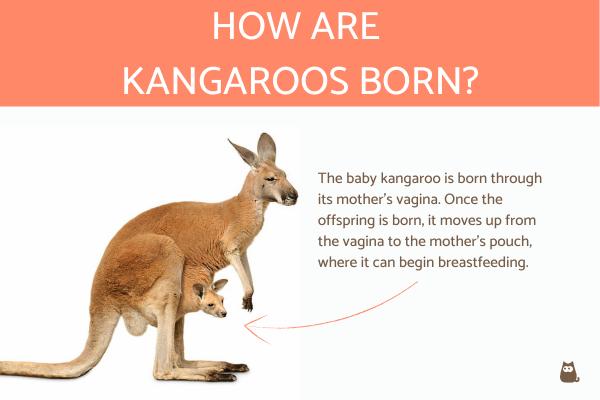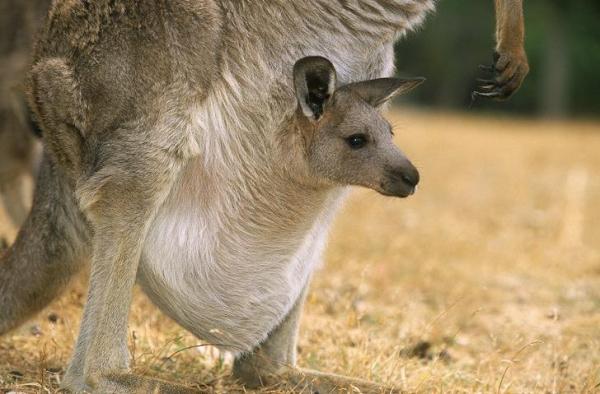
The Kangaroo belongs to the Macropodidae family, which also includes a variety of lesser-known and smaller individuals. Thus, depending on the species, they can be medium to large in size, however, generally the term kangaroo is used to refer to the larger ones.
But, how are kangaroos born? In this AnimalWised article we're going to explain how kangaroos are born. We'll also include a video so you can fully understand a baby kangaroo's birth.
About kangaroos
Kangaroos are primarily native to Australia, although they can also be found in New Guinea and nearby islands. These animals are bipedal because they move by jumping with their two hind legs, which are long and narrow, but very muscular and powerful, which allows them to reach speeds of up to 70 km/h. When they move slowly, they use their non-prehensile tail to support themselves and maintain body balance, an aspect that does not occur when they jump, since locomotion in this way is performed very efficiently.
This is all relevant information to understand certain aspects of the reproduction and birth of kangaroos. The reproduction of kangaroos is a unique process within the animal kingdom, since females are capable of maintaining three offspring of different ages and development times at the same time.
Now, when are kangaroos usually born? The reproductive times of kangaroos can vary from one species to another. For example, in the case of the red kangaroo (Macropus rufus), the environmental conditions must be conducive to breeding, so that they do so in the rainy season so that, when the calf begins its independence from the mother, there is food available. On the other hand, the eastern gray kangaroo (Macropus giganteus) and the western gray kangaroo (Macropus fuliginosus), generally procreate all year round, but the births occur more frequently in the summer so that the young begin their independence of feeding in the spring.
As a fun fact, kangaroos develop a courtship that can last a short time or a couple of days and the males often clash to obtain the right to mate with the female in heat. In this dueling process, the two individuals can fight with their front legs, hence the image of some comics in which we observe two kangaroos boxing. The dominant male may fertilize more than one female in the same season.
You may also want to learn about what kangaroos eat.

How kangaroos are born
Once the female becomes pregnant, she will have a short uterine gestation period. In fact, the gestation of kangaroos is one of the shortest processes in mammals, since it lasts between 28 and 33 days, the latter being the specific period of the red kangaroo. After this time, since the gestation process in the uterus is so short, an underdeveloped embryo is born. They are very small (about 2 cm in average, although it may vary according to the species), hairless and with eyes and ears still in a premature state.
How are kangaroos born?
The baby kangaroo is born through its mother's vagina, as is the case with all placental mammals. The kangaroo's birthing process is fast as without any help and instinctively, the newborn moves up from the vagina to the mother's pouch. This is where it hooks onto the mother's nipple to start feeding. It will take about eight months for the young kangaroo to start to get out of the pouch and begin to fend for itself. At this point, although the baby kangaroo is beginning to feed on its own, it may eventually return to the pouch to continue breastfeeding.
When the female calves and the child leaves the uterus to move to the marsupial bag, the new mother can become pregnant immediately, starting the development of a new embryo. However, because another baby kangaroo is breastfeeding, a process known as embryonic diapause occurs, which consists of paralyzing the growth of the new fetus for about 235 days so that the kangaroo in the pouch continues to grow. After this time, the embryo is reactivated in the uterus, which coincides with the abandonment of the one in the bag.
About a month later, the new kangaroo is born and a third pregnancy can occur, which will follow the same process previously described. In this way, the same female may have a diapaused embryo in the uterus, a growing baby kangaroo in the marsupium and a third offspring who is already moderately independent, but who eventually returns to feed on its mother. In fact, the kangaroo mother has the ability to produce two types of milk: one for the embryo that is developing in the pouch and another for the kangaroo that has already come out of the pouch.
The kangaroo pouch
The word “marsupio” comes from the Latin marsupium and means “bag”. It is a kind of sac that marsupials animals have and in which the development of the immature embryo that has been born is completed. Unlike the outer fur that covers the body of these animals, the inside of the kangaroo pouch is a tissue with very little hair, so much so that the skin is red.
The rearing of the baby kangaroo is carried out by means of the pouch. In this way, within this particular structure are the female's breasts. Thus, the kangaroo pouch is like an epidermal fold that acts as an incubator for the embryo, where it not only feeds, but also maintains the right temperature, being the ideal space in which it is protected from predators and adverse effects. If a newborn does not enter the pouch within a few minutes of being born, it will inevitably die because, as we've previously mentioned, it is a still developing embryo.
Does the male kangaroo have a pouch?
The male kangaroo does not have a pouch since it does not need it, unlike the females in which their breasts are covered by this sac-like fold, protecting the embryo there so that its development culminates while its breastfeeding period occurs. Once the newborn enters the pouch, it firmly attaches its mouth to the mother's nipple, which expands until it fits snugly into the baby kangaroo's mouth.
The animal world never ceases to amaze us with its fascinating and varied reproduction strategies to guarantee the perpetuation of species in ecosystems. In this article we have learned how kangaroos are born, but each species has its own reproduction and birth mechanism, so we encourage you to check out our article about how dolphins reproduce and how turtles and tortoises reproduce.
In the National Geographic video below we can see what the inside of the kangaroo bag looks like and how the offspring is born and how they move towards their mother's pouch.

If you want to read similar articles to How Are Kangaroos Born?, we recommend you visit our Facts about the animal kingdom category.
- Hickman, C., Roberts, L., Parson A. (2000). Comprehensive principles of zoology. McGraw Hill Interamericana, Spain.
- Myers, P. (2001). Macropodidae. Animal Diversity. https://animaldiversity.org/accounts/Macropodidae/